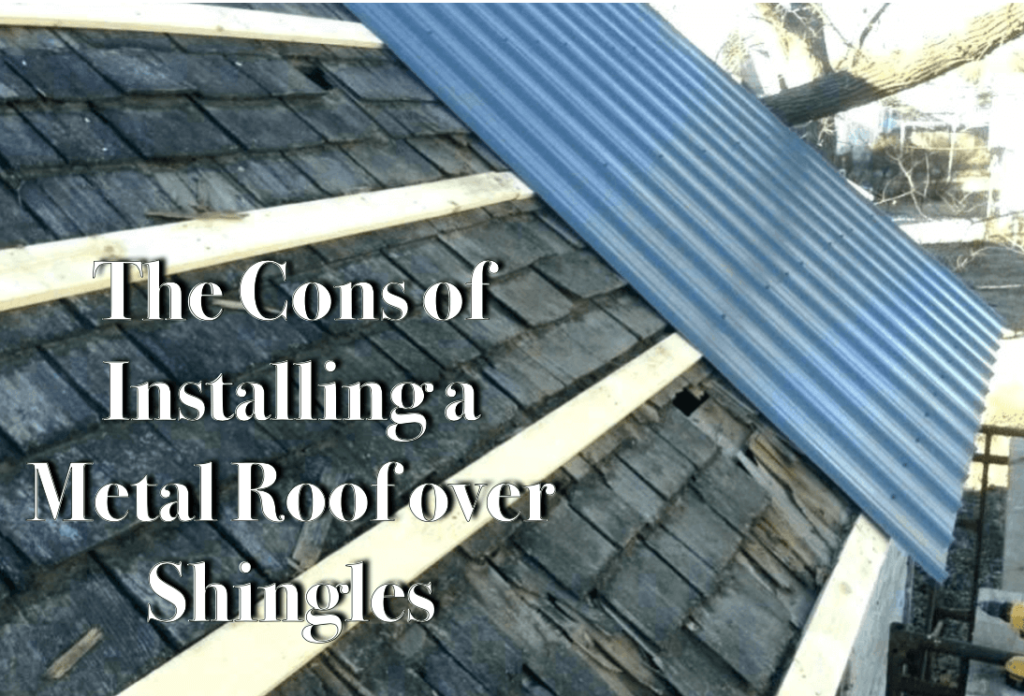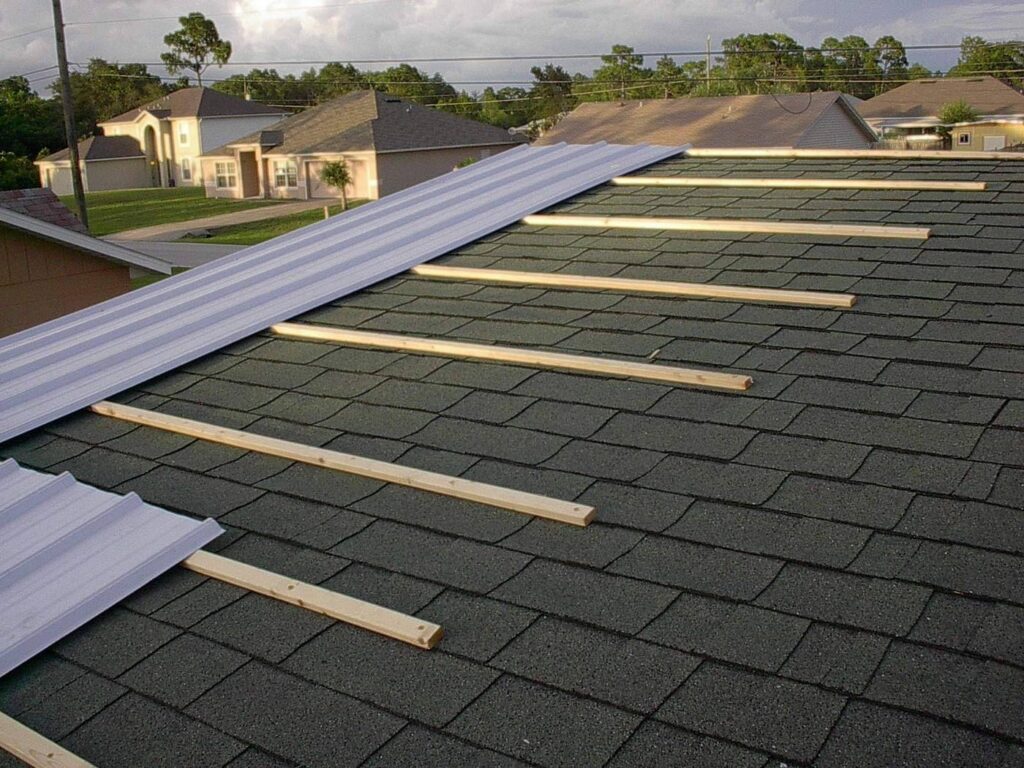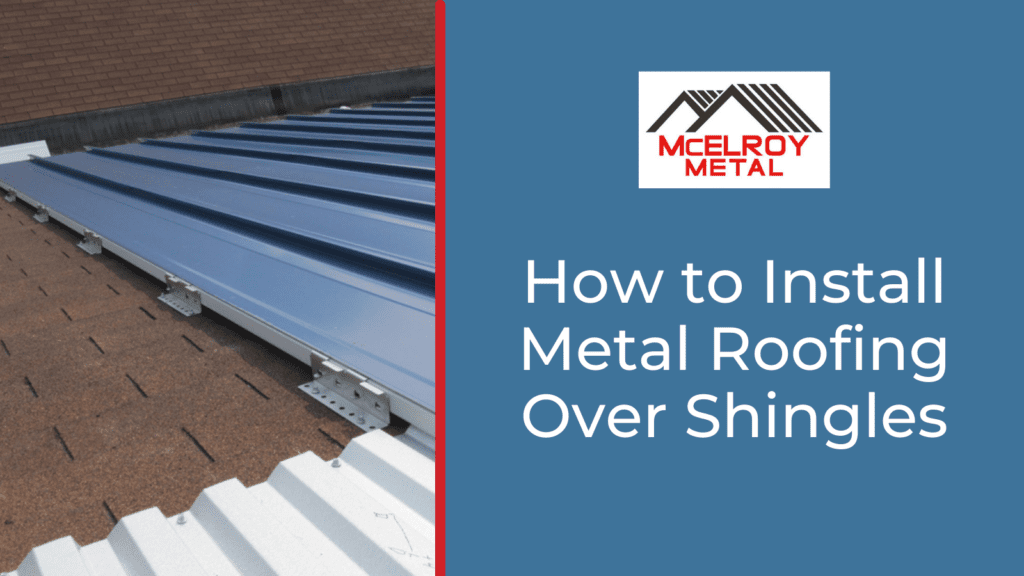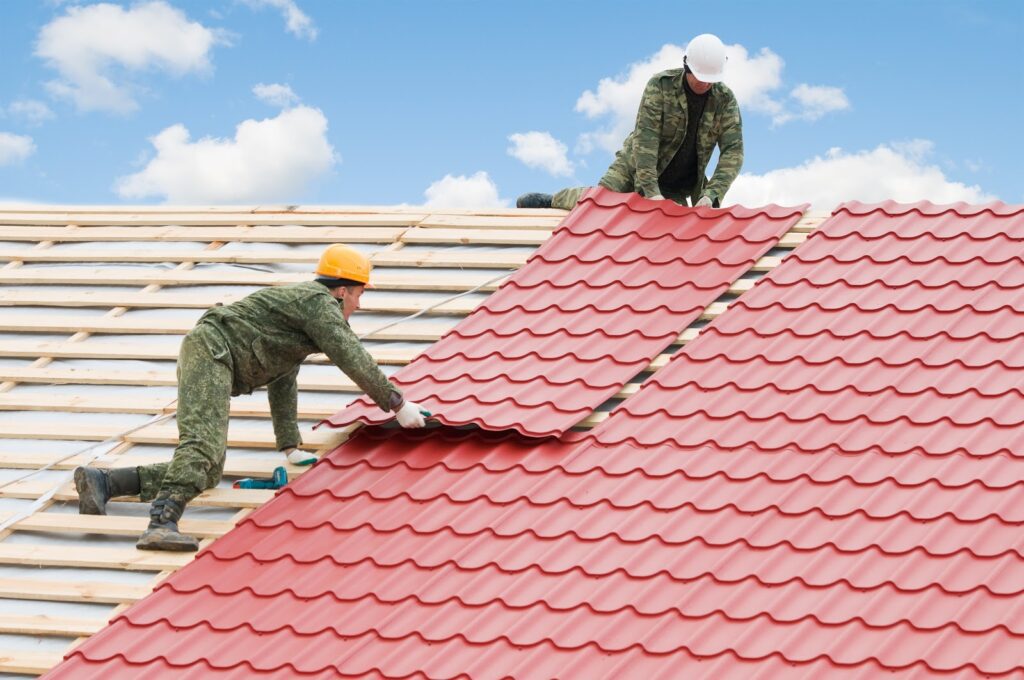So you’re considering upgrading your roof and wondering if you can put a metal roof over your existing shingles? You’re not alone. Many homeowners are curious about this option and the benefits it can bring. In this article, we’ll explore whether it’s possible to install a metal roof over shingles and the potential advantages of doing so. So let’s dive right in and find out if this is the right choice for you and your home.

The Benefits of Installing a Metal Roof Over Shingles
Increased Durability
One of the major benefits of installing a metal roof over shingles is the increased durability it provides. Metal roofs are known for their ability to withstand various weather conditions, including heavy rain, high winds, and even hail. Unlike shingles, which can easily get damaged or torn off during a storm, metal roofs are much more resistant to these types of damages. This means that you can enjoy a long-lasting and reliable roofing system that will protect your home for years to come.
Energy Efficiency
Another advantage of installing a metal roof over shingles is the energy efficiency it offers. Metal roofs are highly reflective and can effectively reduce the amount of heat absorbed by your home during hot summer months. This can result in lower cooling costs as your air conditioning system won’t have to work as hard to maintain a comfortable temperature indoors. Additionally, some metal roofs are designed with insulation features that can further improve energy efficiency and help you save on energy bills throughout the year.
Low Maintenance
Metal roofs are known for their low maintenance requirements, and installing them over shingles is no different. Unlike shingle roofs that may require regular inspections, replacements, or repairs, metal roofs are generally more resistant to damages and deterioration. They are less prone to issues such as mold and algae growth, rotting, or cracking. With a metal roof, you can spend less time and money on maintenance tasks, allowing you to focus on other important aspects of homeownership.
Longevity
When it comes to longevity, metal roofs outshine shingles by a significant margin. While shingle roofs have an average lifespan of around 15 to 30 years, metal roofs can last for 50 years or even longer with proper installation and maintenance. This means that by installing a metal roof over shingles, you can potentially double or triple the lifespan of your roofing system. This longevity translates to long-term cost savings and peace of mind knowing that your roof is built to withstand the test of time.
Enhanced Aesthetics
Installing a metal roof over shingles can also give your home a fresh and modern look. Metal roofs come in a variety of colors, styles, and finishes, allowing you to choose a design that complements your home’s architecture and enhances its curb appeal. Whether you prefer a traditional, sleek, or rustic appearance, metal roofs offer versatility and can transform the overall look of your home. With a metal roof, you can enjoy both the practical benefits and the aesthetic improvements it brings to your property.
Factors to Consider Before Installing a Metal Roof Over Shingles
Roofing Codes and Regulations
Before installing a metal roof over shingles, it is essential to check local building codes and regulations. Different regions may have specific requirements regarding roofing materials, installation methods, and structural considerations. By familiarizing yourself with these regulations, you can ensure that your project meets all necessary standards and avoid potential issues or penalties in the future.
Weight Capacity
Metal roofs are generally heavier than shingles, so it’s crucial to assess the weight capacity of your existing roof structure. Shingles are typically lighter and can be easily supported by most standard residential roof systems. However, metal roofs may require additional reinforcement or modifications to handle the additional weight. Consult with a professional roofing contractor or structural engineer to evaluate whether your roof can support the added load of a metal roof.
Condition of the Existing Shingles
Before installing a metal roof over shingles, it is essential to thoroughly inspect the condition of the existing shingles. If the shingles are severely damaged, deteriorated, or have underlying structural issues, it is recommended to remove them before installing a metal roof. Installing a metal roof over compromised shingles may result in an uneven surface, compromised waterproofing, or potential leaks. A thorough assessment of the shingles will help determine the best course of action for your roofing project.
Roof Structure
The structure of your roof plays a crucial role in determining whether installing a metal roof over shingles is feasible. Different roof designs and pitches may require specific installation methods or additional modifications. For example, roofs with multiple valleys or complex architectural features may pose challenges during the installation process. Hiring a professional who specializes in metal roof installations can help ensure that your roof structure is compatible and properly prepared for the new roofing system.
Ventilation
Proper ventilation is essential for any roofing system, including metal roofs installed over shingles. Adequate ventilation helps regulate temperature and moisture levels in your attic, preventing issues such as condensation, mold growth, or premature roof deterioration. Before installing a metal roof, assess the existing ventilation system and consider any necessary enhancements or modifications to ensure optimal airflow and ventilation for your new roof.
Preparing the Roof for Installation
Inspection and Repair of the Existing Shingles
Before installing a metal roof over shingles, it is crucial to conduct a thorough inspection of the existing shingles. Look for signs of damage, deterioration, or underlying structural issues. Replace any damaged shingles and repair any structural problems to create a solid and even base for the metal roof.
Cleaning the Surface
Before applying any materials, the surface of the existing shingles should be cleaned to ensure proper adhesion. Remove any dirt, debris, or loose particles using a stiff brush or a pressure washer. This step will help create a clean and smooth surface for the installation of the metal roof.
Applying a Moisture Barrier
To prevent moisture intrusion, it is recommended to apply a moisture barrier over the existing shingles. This additional layer helps protect your home from potential leaks and water damage. Ensure that the moisture barrier is applied according to manufacturer instructions and covers the entire roof surface.
Installing Furring Strips
Furring strips are commonly used in metal roof installations to create an even and level surface. They also provide additional ventilation and insulation benefits. Install furring strips perpendicular to the roof rafters, spacing them according to manufacturer guidelines. This step helps ensure proper alignment and secure attachment of the metal roofing panels.
Ventilation Enhancements
Consider enhancing the ventilation system of your roof to ensure optimal airflow and prevent issues such as condensation or moisture buildup. Install ridge vents, soffit vents, or other appropriate ventilation components to promote effective air circulation.
Methods of Installing a Metal Roof Over Shingles
Full Roof Replacement
A full roof replacement involves completely removing the existing shingles and installing the metal roof directly on the roof deck. This method provides a clean and even surface for the metal roof installation, ensuring a secure and long-lasting result. However, it is important to consider the additional costs, time, and labor associated with a full roof replacement.
Installing Battens
Installing battens involves placing horizontal strips or wooden boards over the existing shingles before installing the metal roof. Battens create an air gap between the shingles and the metal panels, allowing for ventilation and minimizing the risk of moisture-related issues. This method is particularly useful when dealing with uneven or damaged shingles.
Installing Over Existing Shingles
Installing the metal roof directly over the existing shingles is an option that can save time and money. However, it is essential to ensure that the existing shingles are in good condition, not excessively damaged, and provide a suitable base for the metal panels. This method may result in a less even surface and may not be recommended in certain situations, such as when the existing shingles are severely deteriorated.

Benefits and Drawbacks of Various Installation Methods
Full Roof Replacement
Benefits:
- Provides a clean and even surface for the metal roof installation, ensuring a secure and long-lasting result.
- Allows for thorough inspection and repair of the roof structure before installing the metal roof.
- Provides an opportunity to enhance insulation and ventilation systems during the replacement process.
Drawbacks:
- Involves additional costs, labor, and time compared to other installation methods.
- May require temporary relocation or protection of personal belongings during the roof replacement process.
- May result in disruption to your daily routine due to the installation process and associated noise.
Installing Battens
Benefits:
- Creates an air gap between the existing shingles and the metal panels, allowing for ventilation and minimizing moisture-related issues.
- Allows for installation on uneven or damaged shingles.
- Can potentially extend the lifespan of the metal roof by providing additional insulation and ventilation benefits.
Drawbacks:
- Adds an additional step to the installation process, requiring more time and labor.
- Requires the proper alignment and attachment of the battens to ensure a secure and level base for the metal roof.
- May result in increased material and installation costs compared to installing directly over existing shingles.
Installing Over Existing Shingles
Benefits:
- Saves time and labor compared to full roof replacement or installing battens.
- Can be a cost-effective option if the existing shingles are in good condition and provide a suitable base for the metal roof.
- May result in a more streamlined installation process.
Drawbacks:
- Relies heavily on the condition of the existing shingles, which may affect the overall durability and longevity of the metal roof.
- May result in a less even surface, potentially affecting the appearance and performance of the metal roof.
- Requires thorough inspection and assessment of the existing shingles to determine their suitability for installation.
Required Tools and Materials
Metal Roofing Panels
Metal roofing panels are the primary material required for installing a metal roof over shingles. Choose a metal roof material that suits your preferences, climate, and budget. Popular options include steel, aluminum, zinc, or copper. Ensure that the metal panels are designed specifically for residential roofing applications.
Sealants and Fasteners
Various sealants and fasteners are needed to secure the metal roofing panels and ensure a leak-free installation. Use high-quality roofing sealants to seal joints, gaps, and edges to prevent water infiltration. Select appropriate fasteners (nails or screws) based on the metal roof manufacturer’s recommendations and the specific requirements of your roof.
Underlayment
Underlayment serves as an additional layer of protection against moisture and provides thermal insulation. It is typically applied over the existing shingles before installing the metal roof panels. Choose underlayment materials that are specifically designed for metal roofing applications for optimal performance.
Furring Strips
Furring strips are horizontal strips or wooden boards that create an even surface for the metal roof installation. They also provide ventilation and insulation benefits. Choose furring strips that are compatible with the metal roofing panels and ensure proper spacing and alignment during installation.
Safety Equipment
When working on a roof, it is crucial to prioritize safety. Ensure that you have the necessary safety equipment, such as fall protection gear, gloves, goggles, and a helmet. Additionally, consider using a ladder stabilizer or roof brackets to provide stability and prevent accidents while working at heights.

Steps for Installing a Metal Roof Over Shingles
Preparing the Roof
Thoroughly inspect the existing shingles and assess their condition. Replace any damaged shingles and repair any structural issues. Clean the surface by removing dirt, debris, and loose particles. Apply a moisture barrier over the shingles to prevent moisture intrusion.
Applying the Underlayment
Install underlayment materials over the existing shingles according to manufacturer guidelines. Ensure that the underlayment covers the entire roof surface and is properly secured. This step provides an additional layer of protection against moisture and thermal insulation.
Installing Furring Strips or Battens
If using furring strips, install them perpendicular to the roof rafters, ensuring proper spacing and alignment. If using battens, place them horizontally over the existing shingles. Ensure that the furring strips or battens are securely attached to the roof deck, providing an even and level surface for the metal roofing panels.
Installing Metal Roofing Panels
Begin installing the metal roofing panels from the bottom edge of the roof, working your way up. Ensure proper alignment and overlap between panels, following the manufacturer’s instructions. Attach the panels securely using the recommended fasteners, ensuring that they penetrate the furring strips or battens and the roof deck.
Securing the Roofing Panels
Once the metal roofing panels are in place, secure them by sealing any joints, gaps, or edges using high-quality roofing sealants. This step helps ensure a watertight and durable installation. Double-check that all fasteners are properly tightened and that the panels are securely attached.
Finishing Touches
Inspect the entire roof installation to ensure it meets your expectations and adheres to manufacturer guidelines. Clean up any debris or leftover materials from the installation process. Conduct a final walkthrough to ensure that all elements, such as ventilation components and flashings, are properly installed.
Potential Issues and Precautions
Added Weight
Installing a metal roof over shingles adds additional weight to your roof structure. It is crucial to evaluate the weight capacity of your existing roof and consider any necessary reinforcements or modifications before proceeding with the installation. Failure to address weight limitations can result in structural damage or even a collapse.
Layering Effects
Layering multiple roofing materials can affect the performance and lifespan of the metal roof. Heat buildup between the shingles and metal panels can accelerate deterioration and reduce the overall effectiveness of the metal roof. Ensure that the existing shingles are in good condition and will not compromise the performance of the metal roofing system.
Ventilation Challenges
Proper ventilation is essential for any roofing system, including metal roofs installed over shingles. Ensure that your ventilation system is adequate and meets the requirements for your specific roofing configuration. Failure to address ventilation challenges can result in moisture-related issues, such as condensation or mold growth.
Warranty Considerations
Some metal roof manufacturers have specific warranty requirements and limitations for installations over existing shingles. Ensure that your installation method meets the manufacturer’s guidelines to avoid any potential warranty issues. It is recommended to consult with the manufacturer or a professional roofing contractor to ensure compliance with warranty specifications.
Professional Assistance
Installing a metal roof over shingles can be a complex project that requires expertise and experience. It is advisable to seek professional assistance from a qualified roofing contractor. A professional can assess the condition of your existing roof, recommend the best installation method, and ensure that the installation complies with local building codes and regulations.

Cost Considerations
Material Costs
The cost of materials for installing a metal roof over shingles depends on various factors, including the type of metal panels, their quality, and the size of your roof. Metal roofing materials can range in price, with higher-quality options generally being more expensive. Ensure that you budget accordingly and consider the long-term benefits and durability of the chosen materials.
Labor Costs
Labor costs vary depending on the complexity of the installation, the size of your roof, and the specific requirements of your project. Installing a metal roof over shingles may require additional labor compared to traditional roof replacements. Obtain quotes from multiple roofing contractors to ensure competitive pricing and quality workmanship.
Removal of Existing Shingles
If you opt for a full roof replacement, the cost of removing the existing shingles should be taken into account. The labor and disposal fees for removing the old shingles can add to the overall project cost. Discuss the removal process with your roofing contractor to understand the associated charges and logistics.
Additional Repairs or Modifications
During the installation of a metal roof over shingles, additional repairs or modifications may be necessary to address any underlying structural issues, ventilation challenges, or other specific requirements. These additional repairs or modifications should be factored into the overall cost estimation for your project.
Conclusion
Installing a metal roof over shingles can provide numerous benefits, including increased durability, energy efficiency, low maintenance, longevity, and enhanced aesthetics. However, before undertaking such a project, it is essential to consider factors such as roofing codes and regulations, weight capacity, condition of the existing shingles, roof structure, and ventilation. Properly preparing the roof, selecting the right installation method, and using the required tools and materials are crucial for a successful installation. It is important to be aware of potential issues and take necessary precautions to ensure the longevity and performance of the metal roof. Finally, evaluating the cost considerations and seeking professional assistance will help you make an informed decision that aligns with your budget and goals. By taking these aspects into account, you can enjoy the benefits of a metal roof that not only protects your home but also enhances its overall value and appeal in the long run.
